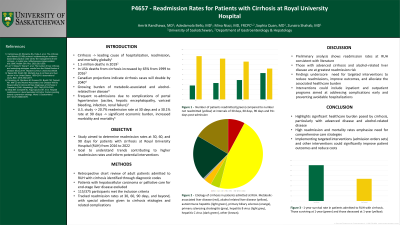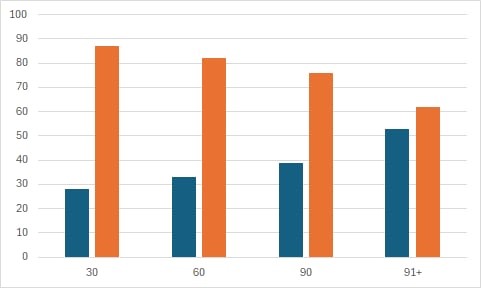Tuesday Poster Session
Category: Liver
P4657 - Readmission Rates for Patients with Cirrhosis at Royal University Hospital
Tuesday, October 29, 2024
10:30 AM - 4:00 PM ET
Location: Exhibit Hall E

Has Audio
- AR
Amrik SC Randhawa, MD
University of Saskatchewan
Saskatoon, SK, Canada
Presenting Author(s)
Amrik SC. Randhawa, MD, Zunaira Shahab, MD, Sophia Quan, MD, Mina Niazi, MD, Adedamola Bello, MD
University of Saskatchewan, Saskatoon, SK, Canada
Introduction: Cirrhosis is one of the leading global cause of hospitalization, readmission, and death, with 1.5 million attributed deaths in 2019. Cirrhosis-related deaths in the US have increased by 65% from 1999 to 2016. Canadian projections indicate a doubling of cirrhosis cases by 2040, largely due to metabolic-associated and alcohol-related liver disease. Patients with cirrhosis require frequent admissions due to portal hypertension-related complications, including ascites, hepatic encephalopathy, variceal bleeding, infection, and renal failure. A US study found a 20.7% readmission rate at 30 days and a 30.1% rate at 90 days. Cirrhosis-related readmissions increase the economic burden, and is associated with increased morbidity and mortality.
Methods: The aim of this project was to determine readmission rates at 30, 60, and 90-day intervals. A retrospective chart review was conducted to ascertain the cirrhosis readmission rate among adult patients at the Royal University Hospital (RUH) between 2016 and 2022. Patients were identified based on their admission diagnostic codes. Exclusion criteria included patients with hepatocellular carcinoma and those receiving palliative care for end-stage liver disease. Of 375 charts reviewed,115 participants were included in the study.
Results: Readmission rates at RUH match or surpass previously cited rates. As shown in Figure 1, readmission rates were 24% at 30 days, 28% at 60 days, 34% at 90 days, and 46% at 91+ days. Almost half of the patients (53/115) had cirrhosis secondary to alcohol use. Other etiologies included hepatitis C (24/115), metabolic steatosis (9/115), autoimmune causes (5/115), primary biliary cholangitis (4/115), and primary sclerosing cholangitis (1/115), and 19/115 had cryptogenic cirrhosis. Patients with underlying alcohol-related liver disease and those with two or more portal hypertension-related complications had higher readmission rates. The population with a higher readmission rate had a greater than 40% mortality within one year.
Discussion: Our preliminary data analysis shows rates in accordance with the literature. As expected, advanced disease and alcohol-related liver disease predict increased readmission risk. Our study highlights areas for intervention to reduce readmission, improve patient outcomes, and reduce healthcare costs. Our hope is to implement inpatient and outpatient intervention to reduce readmission rate in this patient population.

Disclosures:
Amrik SC. Randhawa, MD, Zunaira Shahab, MD, Sophia Quan, MD, Mina Niazi, MD, Adedamola Bello, MD. P4657 - Readmission Rates for Patients with Cirrhosis at Royal University Hospital, ACG 2024 Annual Scientific Meeting Abstracts. Philadelphia, PA: American College of Gastroenterology.
University of Saskatchewan, Saskatoon, SK, Canada
Introduction: Cirrhosis is one of the leading global cause of hospitalization, readmission, and death, with 1.5 million attributed deaths in 2019. Cirrhosis-related deaths in the US have increased by 65% from 1999 to 2016. Canadian projections indicate a doubling of cirrhosis cases by 2040, largely due to metabolic-associated and alcohol-related liver disease. Patients with cirrhosis require frequent admissions due to portal hypertension-related complications, including ascites, hepatic encephalopathy, variceal bleeding, infection, and renal failure. A US study found a 20.7% readmission rate at 30 days and a 30.1% rate at 90 days. Cirrhosis-related readmissions increase the economic burden, and is associated with increased morbidity and mortality.
Methods: The aim of this project was to determine readmission rates at 30, 60, and 90-day intervals. A retrospective chart review was conducted to ascertain the cirrhosis readmission rate among adult patients at the Royal University Hospital (RUH) between 2016 and 2022. Patients were identified based on their admission diagnostic codes. Exclusion criteria included patients with hepatocellular carcinoma and those receiving palliative care for end-stage liver disease. Of 375 charts reviewed,115 participants were included in the study.
Results: Readmission rates at RUH match or surpass previously cited rates. As shown in Figure 1, readmission rates were 24% at 30 days, 28% at 60 days, 34% at 90 days, and 46% at 91+ days. Almost half of the patients (53/115) had cirrhosis secondary to alcohol use. Other etiologies included hepatitis C (24/115), metabolic steatosis (9/115), autoimmune causes (5/115), primary biliary cholangitis (4/115), and primary sclerosing cholangitis (1/115), and 19/115 had cryptogenic cirrhosis. Patients with underlying alcohol-related liver disease and those with two or more portal hypertension-related complications had higher readmission rates. The population with a higher readmission rate had a greater than 40% mortality within one year.
Discussion: Our preliminary data analysis shows rates in accordance with the literature. As expected, advanced disease and alcohol-related liver disease predict increased readmission risk. Our study highlights areas for intervention to reduce readmission, improve patient outcomes, and reduce healthcare costs. Our hope is to implement inpatient and outpatient intervention to reduce readmission rate in this patient population.

Figure: Figure 1 - Number of patients readmitted (blue) compared to number not readmitted (orange) at intervals of 30 days, 60 days, 90 days and 91+ days post-admission
Disclosures:
Amrik Randhawa indicated no relevant financial relationships.
Zunaira Shahab indicated no relevant financial relationships.
Sophia Quan indicated no relevant financial relationships.
Mina Niazi indicated no relevant financial relationships.
Adedamola Bello indicated no relevant financial relationships.
Amrik SC. Randhawa, MD, Zunaira Shahab, MD, Sophia Quan, MD, Mina Niazi, MD, Adedamola Bello, MD. P4657 - Readmission Rates for Patients with Cirrhosis at Royal University Hospital, ACG 2024 Annual Scientific Meeting Abstracts. Philadelphia, PA: American College of Gastroenterology.

